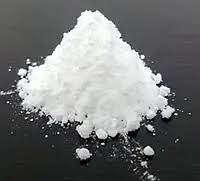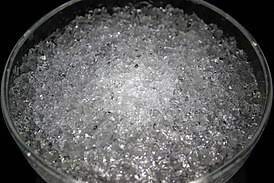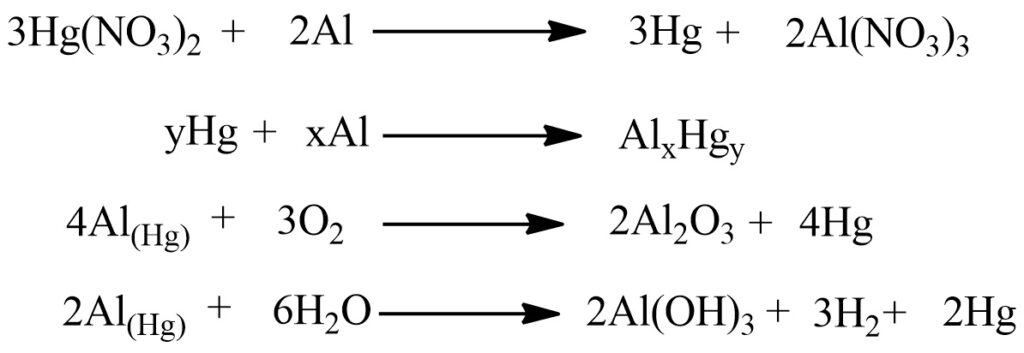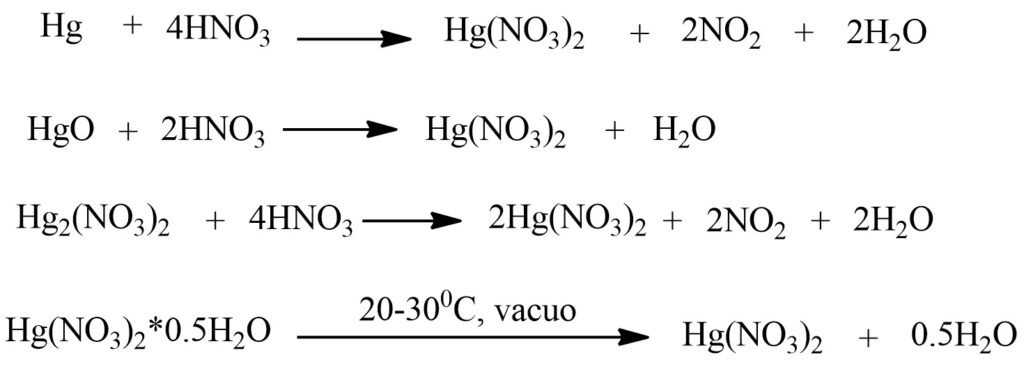- The process of creating a drug - May 23, 2023
- How do scientists model mental disorders in animals? - May 23, 2023
Abstract
Mercury(II) nitrate is an inorganic compound, a salt of mercury and nitric acid with the chemical formula Hg(NO3)2. It forms colorless crystals that are soluble in acidic aqueous solutions. It is toxic, hydrolyzes in hot water, and forms crystalline hydrates. This article presents a comprehensive overview of Mercury(II) nitrate, including its general information, physico-chemical properties, chemical reactions, synthesis of Hg(NO3)2, conclusion, and bibliography.
General Information About Hg(NO3)2 [1-5]
Other synonyms names of Hg(NO3)2 are: mercuric dinitrate; Monomercury nitrate; Nitric acid mercury(II) salt; MERCURIC NITRATE
IUPAC Names of Hg(NO3)2: dinitrooxymercury or Mercury(II) nitrate
CAS number is 10045-94-0
Physico-Chemical Properties of Hg(NO3)2 [1-5]
- Molecular Formula Hg(NO3)2*nH2O, were n=1/2; 1; 2; 8
- Molar Weight 324.3 g/mol
- Melting Point 79 ℃
- Solubility: decomposes in 100℃ water; insoluble in ethanol; soluble in acetone; soluble in HNO3; very soluble in 20℃ water
- Color/Form: white crystalline hygroscopic solid
- Very toxic!
Structural formula present on Figure 1.

Powder and crystalline solid possible of the Hg(NO3)2 can be seen in the pictures provided in Figure 2 and Figure 3.


ChemicalReactions[1-5]
Mercury(II) nitrate, in its divalent form, is known to be highly toxic. Exposure to this compound can have severe health effects. Inhalation or ingestion of mercury(II) nitrate can lead to acute poisoning, causing symptoms such as abdominal pain, nausea, vomiting, and diarrhea.
Long-term exposure to mercury(II) nitrate can result in chronic toxicity, affecting various organ systems, including the nervous system, kidneys, and respiratory system. It can cause neurological disorders, renal damage, and respiratory difficulties.
Due to its toxicity, proper handling and storage procedures are essential when working with mercury(II) nitrate. Protective measures, such as wearing gloves, goggles, and a respirator, should be followed to minimize the risk of exposure. Disposal of mercury(II) nitrate should be done according to appropriate regulations to prevent environmental contamination.
It is important to note that the toxicity of mercury(II) nitrate highlights the need for caution and adherence to safety protocols when dealing with this compound in laboratory or industrial settings.
The pH of precipitation of mercury(II) oxide at different concentrations of Hg2+ ions: The onset of precipitation occurs at a pH of 1.5 when the concentration is 1 mole/liter and at a pH of 2.4 when the concentration is 0.01 M. Complete precipitation is achieved at pH 5, with a residual ion concentration of less than 10-5 M. When interacting with alkali, a yellow mercury oxide is formed, which has particle sizes up to 4 μm. Red mercury oxide has particle sizes exceeding 8 μm. Figure 4.

The interaction of Hg(NO3)2 with hydrochloric acid upon heating results in the formation of mercury chloride and the volatilization of nitrosyl chloride.
Nitrosyl chloride (NOCl) is a yellowish-brown gas that is volatile and highly reactive. It is formed when nitric acid, which is present in Hg(NO3)2, reacts with hydrochloric acid. Nitrosyl chloride has industrial uses, such as in the production of organic compounds and as a nitrating agent.
The reaction between Hg(NO3)2 and hydrochloric acid is an example of a displacement reaction, where the more reactive chlorine from hydrochloric acid replaces the less reactive nitrate group in Hg(NO3)2.
It is important to note that the reaction should be carried out in a well-ventilated area due to the release of toxic gases, and appropriate safety measures should be taken when handling these chemicals. Figure 5.

The formation of mercury iodides occurs during the equimolar mixing of solutions of respective salts. When an excess of iodides is present, mercury binds to form complex tetrakis(iodo)mercurate compounds.
Mercury iodides, such as mercuric iodide (HgI2), are formed when solutions of mercury salts and iodide salts are combined in equivalent amounts. Mercuric iodide is a bright red compound that is sparingly soluble in water but dissolves readily in organic solvents. It has applications in various fields, including as a pigment and in the manufacture of electrical components.
In the presence of an excess of iodides, mercury can form complex compounds known as tetrakis(iodo)mercurate complexes. These complexes, such as tetrakis(iodo)mercurate(II) (HgI42-), are formed by the coordination of mercury ions with multiple iodide ions. These complexes often have unique properties and are utilized in areas such as coordination chemistry and material science. Figure 6.

Upon heating, mercury(II) oxide undergoes decomposition, resulting in the formation of red mercury oxide, which further transforms into metallic mercury with the release of oxygen.
The first product of decomposition is red mercury oxide (HgO), which is also known as mercuric oxide. Red mercury oxide is a crystalline solid that possesses a distinct red color.
Continuing the heating process, red mercury oxide undergoes further transformation. It decomposes into metallic mercury (Hg) and releases oxygen gas (O2). Figure 7.

Hydrolysis of mercury(II) nitrate occurs in warm water and diluted solutions, resulting in the formation of basic salts.
When mercury(II) nitrate (Hg(NO3)2) is exposed to warm water or diluted solutions, it undergoes hydrolysis. During hydrolysis, the nitrate ions (NO3–) react with water molecules (H2O), leading to the formation of hydroxide ions (OH–) and nitric acid (HNO3).
The hydroxide ions subsequently react with the mercury ions (Hg2+) present in the solution, resulting in the formation of basic salts. These basic salts are compounds where the mercury ion is coordinated with hydroxide ions.
The specific basic salts formed during the hydrolysis of mercury(II) nitrate will depend on various factors such as the concentration of the solution, temperature, and reaction conditions. Figure 8.

When mercury(II) nitrate (Hg(NO3)2) reacts with metallic mercury (Hg), a redox reaction occurs. The metallic mercury acts as a reducing agent, transferring electrons to the mercury(II) cation in the nitrate compound.
As a result of this reduction reaction, the mercury(II) cation is converted to monovalent mercury, resulting in the formation of monovalent mercury nitrate (Hg2(NO3)2). Monovalent mercury nitrate is a compound, characterized by its distinct yellow coloration. Figure 9.

The interaction of mercury(II) nitrate with sulfides leads to the formation of cinnabar. Cinnabar is a bright red or reddish-brown crystalline solid that has been historically used as a pigment and in the production of mercury. Figure 10.

Mercury fulminate is obtained by the interaction of mercury nitrate with ethanol in diluted nitric acid. Due to this, it is not advisable to leave mercury salts in a solution with ethanol for an extended period of time. When attempting to evaporate such solutions, a severe explosion can occur. Mercury fulminate is an initiating explosive material.
Mercury fulminate (Hg(CNO)2) is a highly sensitive and explosive compound. It is commonly used as a primary explosive in detonators and percussion caps due to its extreme sensitivity to shock and friction. Even small amounts of mercury fulminate can detonate violently upon ignition.
The process of obtaining mercury fulminate involves the reaction between mercury nitrate (Hg(NO3)2) and ethanol in diluted nitric acid. However, handling mercury fulminate requires extreme caution and expertise due to its instability and explosive nature. Figure 11.

When mercury(II) nitrate reacts with more reactive metals such as copper (Cu), silver (Ag), gold (Au), aluminum (Al), etc., metallic mercury is displaced, forming amalgams with these metals. The reaction between mercury(II) nitrate (Hg(NO3)2) and more reactive metals results in a displacement reaction. In this reaction, the more reactive metal displaces the mercury cation from the nitrate compound. Metallic mercury has the ability to form amalgams, which are alloys formed by the combination of mercury with other metals. Figure 12.

Synthesis of Hg(NO3)2 [1]
The synthesis of mercury nitrate can be achieved by dissolving metallic mercury or its oxide in nitric acid, as well as by boiling mercury(I) nitrate in nitric acid. The anhydrous form of the salt is obtained through vacuum drying. The synthesis process can be further understood by referring to the scheme illustrated in Figure 13.

Conclusion
Mercury(II) nitrate (Hg(NO3)2) is an inorganic compound consisting of mercury ions and nitrate ions. In chemical reactions and interactions, mercury(II) nitrate exhibits its characteristic properties. It is highly toxic and should be handled with caution. The interaction of mercury(II) nitrate with various substances can lead to the formation of diverse compounds. With metals more reactive than mercury, it can react, displacing metallic mercury and forming amalgams. Heating mercury(II) nitrate can cause its decomposition, resulting in the formation of red mercury oxide (HgO), which further, upon continued heating, can transform into metallic mercury with the release of oxygen. Additionally, it is worth noting that the interaction of mercury(II) nitrate with sulfides can lead to the formation of cinnabar (HgS). Overall, studying mercury(II) nitrate and its properties is important for understanding the chemistry of mercury and its interactions with other compounds. However, considering its high toxicity, proper precautions should be taken when working with this compound.
Bibliography
- https://en.wikipedia.org/wiki/Mercury(II)_nitrate
- https://pubchem.ncbi.nlm.nih.gov/compound/16683796
- https://www.chemspider.com/Chemical-Structure.23247.html
- https://www.musechem.com/product/mercuric-nitrate-m120897/
- https://en.wikipedia.org/wiki/Mercury_poisoning
- https://en.wikipedia.org/wiki/Amalgam_(chemistry)
- https://bbgate.com/threads/aluminium-amalgam-al-hg-summary.1271/




